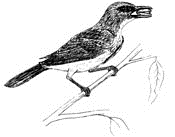Vertebrate Pest Conference: Proceedings

Vertebrate Pest Conference Proceedings: 17th (1996)
Date of this Version
1996
Document Type
Article
Citation
Published in Proceedings: Seventeenth Vertebrate Pest Conference … 1996, ed. Robert M. Timm & A. Charles Crabb (University of California, Davis, 1996).
Abstract
In the Nepalese Himalaya conflict with rural communities due to livestock predation to large carnivores like snow leopard, common leopard, wolf and wild dog has risen sharply in recent years. This increase is attributed to a number of factors, including implementation and enforcement of wildlife protection laws (which have permitted a recovery in carnivore numbers), the creation of protected areas (which serve as refuges from which predators can populate the surrounding area), the depletion of natural prey due to poaching and loss of habitat, and lax livestock herding practices. However, little information is presently available upon which to design remedial programs. U.S. AID provided research funding for an in-depth assessment of snow leopard predation in the Annapurna Conservation Area (ACAP), a new innovative approach to nature conservation. Baseline information on livestock numbers and mortality were gathered during household interviews, followed by field surveys to assess animal husbandry systems, map pastures, establish periods of use and estimate stocking rates, and to characterize habitat using randomly located plots. Data substantiate the existence of depredation "hotspots," where high loss occurs, in some cases exceeding 14% to 20% of the livestock population over a short period. Losses varied seasonally, and from year to year. Small-bodied stock like goat and sheep were more vulnerable than large-bodied stock like yak, although horses were especially vulnerable. Factors most closely associated with predation included lack of guarding (or very lax supervision), especially during the daytime, and repeated use of pastures where livestock depredators were known to be actively hunting. Herders usually reacted to repeated depredation incidents by attempting to trap or shoot the suspected culprit until losses declined to an acceptable level. As large carnivore populations become increasingly fragmented and genetically isolated, new management strategies are urgently needed, especially within the buffer zones and intervening corridors between separated parks and reserves. People reside within nearly all Himalayan protected areas, and such issues as loss of livestock and competition between wildlife and livestock cannot be avoided. A plan is offered for alleviating livestock loss in the Annapurna Conservation Area that involves local institutions in decision-making, rewards sound husbandry practices, strengthens indigenous institutions, without further eroding ACAP's unique biological diversity and diverse carnivore population. The authors believe these measures and ideas could be fruitfully extended to other parts of the Himalaya.
Included in
Animal Sciences Commons, Bioresource and Agricultural Engineering Commons, Environmental Engineering Commons


Comments
Copyright © 1996 (where applicable) by the Vertebrate Pest Council of the Vertebrate Pest Conference. Used by permission.